
Couscous – sometimes called kusksi or kseksu – is a Maghrebi dish of small steamed granules of rolled durum wheat semolina that is often served with a stew spooned on top. Pearl millet, sorghum, bulgur, and other cereals are sometimes cooked in a similar way in other regions, and the resulting dishes are also sometimes called couscous.

Mămăligă is a porridge made out of yellow maize flour, traditional in Romania, Moldova and West Ukraine. Poles from the Lviv area also prepare this traditional dish. It is also a traditional dish in Thessaly and Fthiotis, Greece. In Italy, Portugal, Switzerland, Slovenia, Croatia and many other countries, this dish is known as polenta.

Merguez is a red, spicy mutton- or beef-based fresh sausage in Maghrebi cuisine. Since the late 20th century, it has been popular in France and Great Britain due to the large Algerian populations.
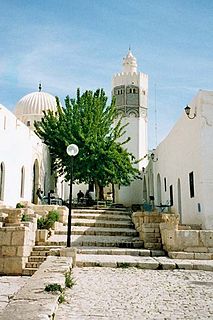
El Kef, also known as Le Kef, is a city in northwestern Tunisia. It serves as the capital of the Kef Governorate.

The cuisine of Senegal is a West African cuisine influenced by North African, French, and Portuguese cuisine and derives from the nation's many ethnic groups, the largest being the Wolof. Islam, which first penetrated the region in the 11th century, also plays a role in the cuisine. Senegal was a colony of France until 1960. Ever since its colonization, emigrants have brought Senegalese cuisine to many other regions.

Kilien Stengel, is a French gastronomic author, restaurateur, and cookbook writer. He has worked at Gidleigh Park, Nikko Hotels, Georges V Hotel in Paris, and in a number of Relais & Châteaux restaurants. He was a teacher of gastronomy at the Académie of Paris and of Orléans-Tours. Stengel works at the European Institute for the History and Culture of Food at François Rabelais University. He is captain of a culinary book fair, en directot of a collection book. Usually, he work for Ministère de l'Éducation nationale teacher competition, Meilleur Ouvrier de France award, and Masterchef France. In 2015 his PhD in information science was supervised by J-J. Boutaud.

Dar al-Magana is a 14th-century building in Fes, Morocco, built by the Marinid Sultan Abu Inan Faris which houses a weight-powered water clock. It is located opposite the Bou Inania Madrasa on Tala'a Kebira street and was created to serve that madrasa and its mosque, which was also built by Abu Inan around the same time.
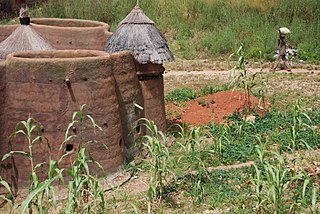
The Tammari people, or Batammariba, also known as Otamari, Ottamari, or Somba, are an Oti–Volta-speaking people of the Atakora Department of Benin and neighboring areas of Togo, where they go by the name of Taberma. They are famous for their two-story fortified houses, known as Tata Somba, in which the ground floor houses livestock at night, internal alcoves are used for cooking, and the upper floor contains a rooftop courtyard that is used for drying grain, as well as containing sleeping quarters and granaries. These evolved by adding an enclosing roof to the clusters of huts, joined by a connecting wall that is typical of Gur-speaking areas of West Africa.

Beninese cuisine is known in Africa for its exotic ingredients and flavorful dishes. Beninese cuisine involves many fresh meals served with a variety of sauces. Meat is usually quite expensive, and meals are generally light on meat and generous on vegetable fat.
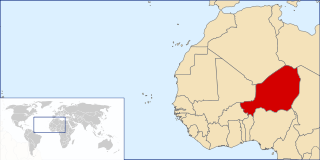
The cuisine of Niger draws on traditional African cuisines. Various spices are used and meals include grilled meat, seasonal vegetables, salads, and various sauces. Meals in Niger usually start with colorful salads made from seasonal vegetables. Moringa leaves are a favorite for a salad.
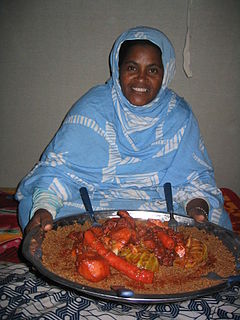
The cuisine of Mauritania includes the culinary practices of Mauritania. Historically, what is now Mauritania has been influenced by Arab and African peoples who have lived in and traversed the "stark" landscape marked with Sahara desert dunes in caravans. There is an overlap with Moroccan cuisine in the north and Senegalese cuisine in the south.

Bissau-Guinean cuisine is the food culture of Guinea-Bissau, a nation on Africa's west coast along the Atlantic Ocean. Rice is a staple in the diet of residents near the coast and millet a staple in the interior. Much of the rice is imported and food insecurity is a problem in large part due to coups, corruption and inflation. Cashews are grown for export. Coconut, palm nut, and olives are also grown.

The ruins of Loropéni are a medieval heritage site near the town of Loropéni in southern Burkina Faso. They were added to the UNESCO World Heritage List in 2009. These ruins are the country's first World Heritage site. The site, which spans 11,130 square metres (119,800 sq ft), includes an array of stone walls that comprised a medieval fortress, the best preserved of ten in the area. They date back at least a thousand years. The settlement was occupied by the Lohron or Kulango people and prospered from the trans-Saharan gold trade, reaching its height between the 14th and 17th centuries AD. It was abandoned in the early 19th century.

TiVi5 Monde, stylized as TiVi5 MONDE, is an international pay television channel launched at the end of January 2012 by the Francophone network TV5 Monde, which is aimed mainly to French-speaking African children. Its main goal is to teach French to young children through dedicated programs.

Mohamed Mbougar Sarr is a Senegalese writer. Raised in Diourbel, Senegal and later studying in France, Sarr is the author of four novels as well as a number of award-winning short stories. He won the 2021 Prix Goncourt for his novel La plus secrète mémoire des hommes, becoming the first Sub-Saharan African to do so.

Fatou Sow is a Senegalese feminist sociologist specialising in sociology of gender.
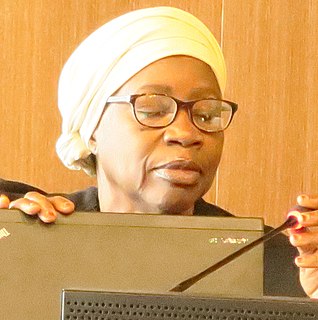
Codou Bop is a Senegalese sociologist, journalist and women's rights activist who also engages against gender violence in Sub-Saharan Africa.

Hakim Hajoui is a Moroccan diplomat. He was appointed ambassador of Morocco to the United Kingdom in 2020.
Isidore Ndaywel è Nziem, is a Congolese historian and linguist. He is the author of several essays, studies and other publications about the history of the Congo, including the overview work L'histoire générale du Congo: De l'héritage ancien à la République démocratique.

Sebiba is the term used in Algeria to designate a festival and the Tuareg people's dance performed on this occasion and accompanied by female drummers in the Sahara oasis of Djanet in the Tassili n'Ajjer region in southern Algeria. The dance originated among the descendants of black African slaves and is part of the celebrations for the Islamic Ashura Festival. The dance was recognized by UNESCO in 2014 for its significance to humanity's intangible cultural heritage.




















